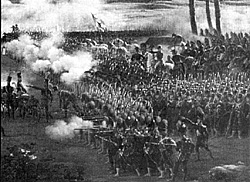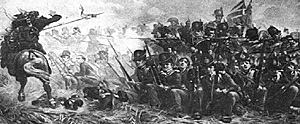 Printed with Brent Nosworthy's permission. This book is available from Sarpedon Publishers, 166 Fifth Ave.., NY, NY, 10010 (ISBN 1-885119-27-5).
Printed with Brent Nosworthy's permission. This book is available from Sarpedon Publishers, 166 Fifth Ave.., NY, NY, 10010 (ISBN 1-885119-27-5).
Note: This lengthy chapter has been divided into two sections.--RL.
Although the square was not completely unknown during the seventeenth centuity an ad hoc formation which required more time to form than was available during actual battlefield conditions. With the adoption of cadence by the Prussian infantry during the 1730s and other armies between 1748 and 1752, it became much more feasible to form square in the heat of an action.
When compared to the Napoleonic Wars, however, the use of squares during the SYWar remained relatively rare. The reason for this lay not in the inability of the infantry to form square quickly -- atthis point all the armies in Western Europe were quickly adopting cadenced marching and new maneuvers -- but rather in the grand tactical implications that resulted once one or more squares were formed. The practice of forming long continuous battle was simply inimical to the use of squares. If one or more battalions along a lengthy line were to form square, the adjoining battalions would now have a flank exposed and could be easily rolled up by the enemy cavalry.
So, either all the battalions along the line had to form square, or those that remained in line somehow had to protect any exposed flanks either by throwing back part of the line en potence (part of the line was run perpendicularly backward) or en crochet (part of the line was thrown back at an angle) or anchoring it behind some natural form of protection such as a morass, gully, etc. This might prove to difficult or impossible to do heat of the battle, however.
Once the French started to employ the French school or impulse system of grand tactics, these restrictions were immediately eliminated. In this grand tactical system, battalions were usually maintained in column of waiting. Those lines that were formed were much smaller, i.e., that is they were generally battalion, regimental or brigade-sized lines.
And, a brigade commander could anchor these smaller lines simply by placing a battalion in closed column at an exposed end rather than relying on terrain. All of this meant that a battalion or regiment commander was much more free to form square when threatened by cavalry than his counterparts had been in earlier wars. The result was a proliferation of squares during the French Revolutionary and Napoleonic Wars.
Although the word "square" conjures up battalion-sized formations, there were in fact many different types of squares, ranging from small rallying squares which might only have 15-20 men to army-sized squares. What follows is a description of the largest of these down to the smallest.
Divisional Squares
Although most hollow squares were battalion-sized formations, occasionally commanders were forced to form much larger squares. This usually occurred when a smaller force was cut off from the main body and surrounded by an enemy which though superior in numbers was without artillery. Probably the most notable examples of large-scale squares occurred during the Egyptian Campaign in 1798 and then again during Napoleon's 1812 campaign in Russia.
When the French first arrived in Egypt they held the capabilities of the Mameluke and Turkish horsemen in high regard and were determined to take every precaution against these notoriously savage horseman whose ancestors had proven to be the scourge of south-eastern Europe. As a result, the French army initially moved around the country side in a series of squares for whole days at a time. These squares were formed to protect the sick, wounded and artillery as much as they were to secure the active infantry from Oriental scimitars.
At first, the infantry in these squares were drawn up along six ranks; however, it was gradually discovered these precautions were unnecessary two and three-ranks were employed instead.
[1]
These measures were wisely taken, for the Turks and Mamelukes were skilled horsemen who could penetrate and destroy the Turks and Mamelukes were skilled horsemen who could penetrate and destroy a European formation seemingly within moments, if they were ever given the opportunity of creating a breech. And, at the Battle of the Pyramids (1798) we see both the energy devoted by the French to frustrate these horseman, and on the opposite side how much they were deserving of this respect. Desaix's division had been slightly disordered as it advanced through a wood, and it was only with difficulty and delay that upon learning of the approach of the Mameluke horsemen it was able to form a large divisional square.
In fact, 30 to 40 of the most advanced Mamelukes were able to penetrate the square before it was completely formed. In a smaller square, this would have been enough to disorder the square long enough for the main body to catch up and cut up the formation. However, this was a divisional square that contained thousands of men, and there were enough infantry available to surround and destroy the 30 or so intruders.
Fortunately for the French, the intruders were disposed of and the square completely reformed by the time the main body of enemy cavalry neared. These were kept off with musketry fire and artillery rapidly firing grapeshot. The Mamelukes were able to force a passage through the interval separating Desaix's and Regnier's divisions, which each also deployed in a divisional square. The Mamelukes then circled the two squares much in the fashion we associated with North American Indians circling the archetypical wagon train, and with as much success as the unfortunate Indians in a John Wayne movie.
Despite the casualties inflicted by the French musketry fire, the Mamelukes rode right up to the French infantry, and unable to break through, threw their pistols at their opponent's heads. This incidentally tells us that the most advanced Mamelukes were very close to the defender's between two to eight paces, otherwise, throwing a pistols would be utterly useless. It also strongly suggests that the French infantry fire had devolved into a ragged "voluntary" fire. Had a controlled volley fire by individual ranks been strictly maintained, the horsemen would not have able to remain close to the defenders for more than a few seconds. As the horsemen threatened the infantrymen and forced them to raise their bayonets, some of the attackers dismounted and crawled along the ground until they were two or three feet from the first rank of the defenders.
Here, they started to cut at the French infantry's feet with their scimitars. However, despite these heroic efforts the assailants were mowed down by an "incessant fire on every front" and finally driven off. When the dust had cleared the French had only lost about 200 men.
In many respects this represented the high point for the Mameluke forces. Never again would
they instill the same degree of fear into their French opponents, and the next year when General Kleber with his 6,000 men encountered 30,000 Turks at Mount Thabor he drew up his force in a series of smaller squares. These were able to ward off the the Turkish force for six hours until reinforcements arrived and the enemy dispersed. [2]
Large Squares
The use of these large divisional and army-sized squares was certainly not limited to eastern campaigns. Several instances of the reliance on large divisional squares are also found during the 1812 and 1813 campaigns. On Aug 14th, 1812, Marshals Ney and Murat with 18,000 cavalry near Krasnoi overtook a rearguard made up of 6,000 infantry and 1,200 horse that had been detached from Barclay's main army.
Emerging from a defile near the village of Mhoilow, the larger French force came upon the Russians and immediately formed line under enemy artillery fire. Discovering that it was
surrounded on three sides by French cavalry and its immediate retreat cut off by the Dnieper at its back, the Russian force formed a series of battalion squares. These were positioned on the other side of the Smolensk highway which was lined on both sides by a double row of Poplar trees. As it turned out, this proved to be an excellent defensive position.
Charging through a hail of bullets and into a cloud of smoke, he only had a distinct view of the enemy for a moment, and that probably before the Russians delivered their first fire. His horse though saw the bristling row of bayonets in time to come to an abrupt stop, a foot or two in front of the square. Combe was almost thrown head over heels on top of the defending line, and only managed to stay atop his mount by squeezing his thighs tightly around the horse's back and neck. With great presence of mind, our trooper simultaneously levelled a sabre stroke on top of a hapless infantryman's head.
The squadron, however, had become too disorganized to exploit any individual's success. Suffering many casualties Combe and his colleagues beat a hasty retreat and regrouped behind the remaining squadrons in the regiments, still in column. The other charges met a similar fate, and not a single Russian square was broken during this engagement. [3]
They were still surrounded, however, and the Russian commander, General Neverovski, decided to retreat into a large plain along the river until a suitable bridge would allow him to reunite his forces with the main Russian army. To do this, the battalion squares were first combined into two larger squares. The French meanwhile continued their assaults and are estimated to have launched at least 40 charges that day. A few of these appeared to be on the brink of success as some of the French troopers broke through the Russian ranks bristling with bayonets. They charged into the hollow center and sabered several Russian officers.
The French horsemen were quickly subdued and the integrity of the squares reestablished. Taking casualties, the Russians combined the two squares into a single larger version. All the while slowly retreating, they beat off what must appeared as incessant French charges with a heavy "rolling" fire. Finally, as they reached Kortina night fell. They had survived the repeated attacks of the numerically superior French forces, but sustained the loss of 1,100 men and five pieces of cannon. [4]
Yet another instance of large scale use of squares occurred at the Battle of Leipzig (Oct. 18, 1813) when six battalions of the Young Guard were formed in oblique squares. These succeeded in turning back repeated charges made by both the Austrian and Russian cavalry.
[5]
More Infantry Squares Excerpt
 Trooper Combe who served with the 8th chasseurs à chevaux in his memoirs describes the opening of the engagement.
Trooper Combe who served with the 8th chasseurs à chevaux in his memoirs describes the opening of the engagement.
The French cavalry ployed back into column of squadrons in order that it could hurl a number of charges in succession. Unfortunately, to get to the Russian squares it had to pass through the two rows of Poplars which forced it to open its files in many places along the squadron front. Combe recalls the sensation of approaching the enemy formation.
Back to Age of Napoleon No. 25 Table of Contents
Back to Age of Napoleon List of Issues
Back to MagWeb Master List of Magazines
© Copyright 1998 by Partizan Press.
This article appears in MagWeb (Magazine Web) on the Internet World Wide Web.
Other military history articles and gaming articles are available at http://www.magweb.com